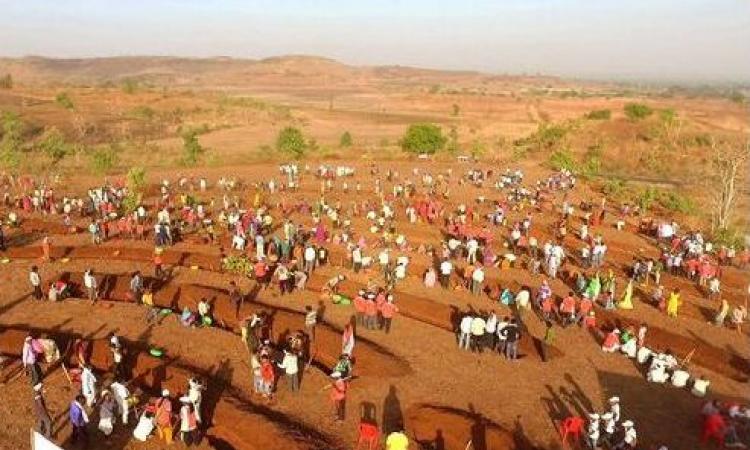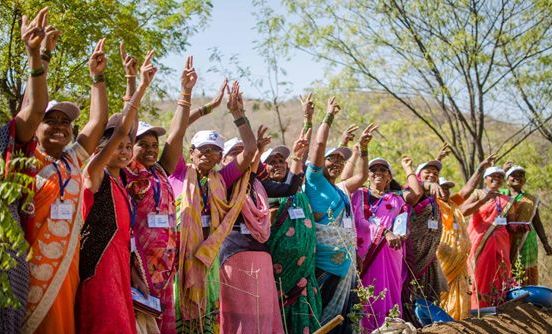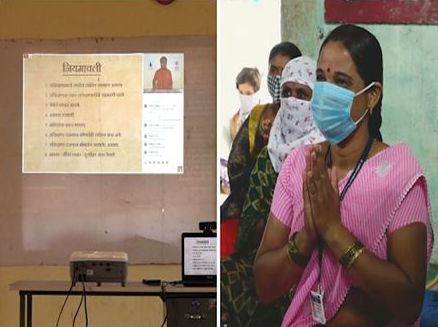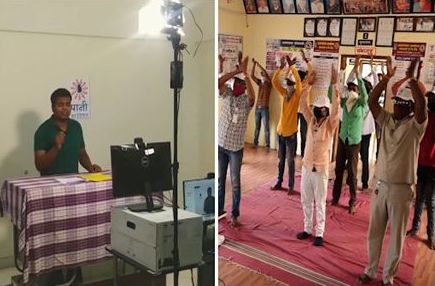
Paani Foundation was created in 2016, with the vision of making Maharashtra drought-free. From 2016 to 2019, Paani Foundation organized four Water Cup competitions, whose main objective was to make villages water secure through watershed development. In 2019, during the last Water Cup, more than 4,700 villages in 76 talukas had joined the movement for change.
By 2020, as thousands of villages became water sufficient, we felt the need to deepen our vision and work towards making every village ‘samruddha’ (prosperous). Thus, was born the Satyamev Jayate Samruddha Gaon Spardha (Satyamev Jayate Prosperous Village Competition) which was launched in 39 talukas of Maharashtra.
This competition provides a roadmap to the village for not only increasing water supply but also planning water usage. It encourages villages to fight climate change through ecological restoration - by nurturing and planting more trees, creating forests and grasslands, and improving soil health. It trains villagers to increase income through greater agricultural productivity and aims to empower them to set up small agri-businesses.
Critical for Paani Foundation has been its guiding principle, viz., villages can only become water secure and samruddha (prosperous), if they truly become the engines of their own growth and development. The villagers plan their own development beginning with watershed works and then graduate to all the activities necessary to make the village prosperous.
They have to execute these activities themselves, which means raising funds, offering sharmadaan, organizing machine work, implementing government schemes, etc. Thus, the relationship of Paani Foundation to the villagers is not based on commercial and monetary considerations, but it is that of a mentor and guide.
What Paani Foundation provides is (i) Training of villagers and (ii) Organizing of the competition. It also provides technical support to villages and helps them liaison with government officials and schemes. This guiding principle of Paani Foundation, bereft of commercial considerations, can only work in practice if it can bring about a sustained behavioural change in the villages and villagers. It is here that Information, Education and Communication (IEC) at scale becomes critical.
Training: The first pillar of IEC
One of the most important components of Paani Foundation’s methodology is its residential four-day training for villages. Villagers from about 8 to 10 villages attend a training together in a specially designed centre, set up in a village that has done outstanding watershed development.
The ambience of the centre is important because the host village and the villagers become a rich source of inspiration for the trainees, who are also villagers. From the moment the participants reach the centre, they are welcomed not just by the training team but more important by villagers, usually with dance and music, through colorful rangolis, many a time through washing their feet, as a symbol of respect and warm welcome. This gives the participants a glimpse of the next four days. It assures them that this training will be joyful and celebratory.
Any behavioral change can only take place if the participants undergo a profound personal experience within these four days. The entire training is designed to create this experience. Not only is the learning of watershed development experiential, but at a personal level, every participant is encouraged to call upon their inner power to change.
The training is conducted by a team of social and technical trainers who are not only carefully selected and rigorously trained, but most importantly, they realise that their work should be a labor of love. It should be looked at as a mission, and not just a job. Their relationship with the villagers should not only be respectful but also based on the belief that the villager is a repository of rich life experiences.

Without the right trainers, the best-written modules can turn to naught. A typical training day begins from 7 am and continues till about 8 pm. For many women, the experience of learning without the cares of family, is so overwhelming, that they continue chatting and discussing with the women trainers into the wee hours of the night. By the fourth day, one can see the changes in the participants from their firm resolution to play a leading role in their village.
The competition – the milieu in which the change is tested
The best training, however transformative, cannot be sustained in practice unless a milieu is created which nourishes and tests this behavioral change. It is here where the competition organized by Paani Foundation becomes critical. The competition is based on a marking system carefully designed whereby different villages can compete on an equal basis.
At the surface, the competition is a race for marks to complete different watershed works along with ecological restoration. However, in reality, it is a road map for the village to become water secure and samruddha. The competition allows Paani Foundation to create in every village an atmosphere for change. The organization of shramadaan, the different methods of mass mobilization, etc., provide the trainees the ground as well as the challenges for putting into practice what the training has empowered them to do.
Shramadaan is viewed by Paani Foundation as an important activity, as it is the best tool to bring a fractured village together. It sometimes happens that despite the competition, the village is just not ready to offer shramdaan. In such situations, trainees have been known to offer shramdaan alone with a firm resolve, even while others have looked on or even mocked them.
While the competition is on, the video team of Paani Foundation releases on social media and various WhatsApp groups, motivational ‘how to’ videos which provide a step by step guide. The social media team of Paani continuously provides a platform to villages and villagers who do outstanding and inspiring work. During the Water Cup Competition, a weekly television program was also hosted by Aamir Khan and Kiran Rao which showcased the miracles being worked on the ground. All this contributed towards creating a climate where behavioral change is encouraged and provided a platform.
Partnership with government – important to complete the ecosystem for change
An important aspect of Paani’s work has been nurturing its relationship with the government, so that officials from top to bottom are involved as important stakeholders in the effort of villagers to become water secure and samruddha. The competition provides an ideal ground for those officers and officials who are committed to using their official positions for public good. Thus, we have had collectors, tehsildars, BDOs, agricultural officers, members of the political class who take part in shramdaan; make schemes available to the people; who go out of their way to provide technical knowledge and administrative procedures to the people. Thus, a new perception and relationship between people and government is forged.
IEC during the pandemic
Since the lockdown was declared in March 2020, Paani Foundation had to cancel all its plans for conducting the four-day overnight residential training for the Samruddha Gaon Spardha. Instead of this training, we conducted important sessions for the villages using an online platform. The trainers were based in a studio in Pune while the village participants assembled in a hall in the village where the session was projected on a screen. Despite serious limitations, the sessions were designed to be interactive. Water activists in villages attended the online trainings and carried out important work in their villages despite the pandemic.


The first steps towards water budgeting were taken when hundreds of villages measured water levels in wells on a regular basis, measured rainfall, carried out a detailed survey of wells and borewells in the village and conducted a survey of crops grown in different seasons. This massive data gathered by the village was analysed and its key findings were communicated back to the villages through ‘X-ray reports’.
Today, villages have begun reserving lands for grasslands and growing nutritious grasses. Thousands of trees have been planted. During the month of August this year, more than two and a half lakh bamboo saplings have been planted to conserve soil on the banks of certain watershed structures. During this kharif season, a digital ‘sheti shala’ or farming school, was conducted for farmers growing soyabean, aimed at increasing agricultural productivity.
We are committed to use the power of all forms of communication to bring about behavioral change and transformation at scale. Each form of communication needs expertise, experience, and constant renewal through feedback. It needs an ability to learn from people and to view them as partners capable of extraordinary actions.
You can go through the following links to access the content created by Paani Foundation:
- The battle against drought: A video chronicling the principles, ethos and method of working of Paani Foundation. We have scaled up multifold since this video, but the heart of our work and principles remain the same.
- A series of animated, instructional videos on watershed management and making watershed structures
- A series of videos on best practices in soil, agriculture and water management (select topics are included, such as drip irrigation, green manuring, making vermicompost, etc.)
- A video on the principles, method and creation of our training programmes
Author: Mr. Lancy Fernandes is the Head of Training at Paani Foundation
/articles/how-paani-foundation-harnesses-power-communication-social-transformation